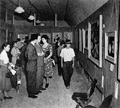Due to the fierceness of the Battle of Okinawa, many of the superb cultural legacies created during the Ryukyu Kingdom Era were lost or destroyed. Gathering up the scattered and lost pieces of this cultural heritage became the start of Okinawa's cultural reconstruction.
The U.S. military expressed understanding of the collection of cultural artifacts. The residents of Shuri collected the cultural properties scattered about and in 1946 opened the Shuri City Folk Museum, which became the Shuri Museum the following year. In 1945 the U.S. military opened the Okinawa Display Hall in the Higashionna area of Ishikawa City . The following year this became the Higashionna Folk Museum.
In May 1953 these museums were consolidated into the Museum of the Government of the Ryukyu Islands, which at present has become the Okinawa Prefectural Museum. In the 1950's the cultural properties were restored and reconstructed. The Sunu-hiyan Utaki Ishimon Stone Gate and Shureimon Gate in Shuri were reconstructed.
The U.S. Civil Administration also established the Ryukyu Cultural Hall and the Ryukyu Friendship Center as facilities for exchange between the Okinawan people and Americans. The educational system was started in the internment camps after the war but a 6-year elementary, a 3-year junior high and 3 year senior high school system was implemented in 1948. In 1950 the University of the Ryukyus was founded on the site of the ruined Shuri Castle.
The field of literature began again. Taking themes from their lives resisting the rule of a foreign nation, writers Tatsuhiro Oshiro and Mineo Higashi both won the prestigious Akutagawa Prize for Literature. In the areas of music and the performing arts, Ryukyuan music and Ryukyuan Dance experienced a great resurgence. The youth of Okinawa took to the jazz and rock they heard from the servicemen on the bases and a new generation of active musicians was fostered. The mixture of jazz, rock, and traditional Okinawan folk songs resulted in the birth of Okinawan Music.

